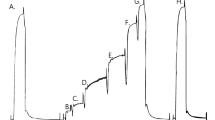Summary
To analyse the fibre type composition of adult dog skeletal muscle, enzyme histochemistry, immunohistochemistry for type I, IIA and IIB myosins, and peptide mapping of myosin heavy chains isolated from typed single fibres were combined. Subdivision of type II fibres into two main classes according to the activity of the m-ATPase after acidic and alkaline preincubation proved to be rather difficult and was only consistently achieved after a very careful adjustment of the systems used. One of these sub-classes of type II fibres stained more strongly for m-ATPase activity after acidic and alkaline preincubation, was oxidative-glycolytic and showed a strong reaction with an anti-type IIA myosin. The other one, however, although unreactive with anti-IIA myosin, was also oxidative-glycolytic, and only showed a faint reaction with an anti-type IIB myosin. Peptide mapping of the myosin heavy chains of typed single fibres revealed two populations of heavy chains among the type II fibre group. Thus, in dog muscle, we are confronted with the presence of two main classes of type II fibres, both oxidative-glycolytic, but differing in the structure of their myosin heavy chains. In contrast to some reports in the literature, no classical type IIB fibres could be detected.
Similar content being viewed by others
References
Aquin L, Banchero N (1981) The cytoarchitecture and capillary supply in the skeletal muscle of growing dogs. J Anat 132:341–356
Billeter R, Weber H, Lutz H, Howald H, Eppenberger HM, Jenny E (1980) Myosin types in human skeletal muscle fibres. Histochemistry 65:249–259
Billeter R, Heizmann CW, Howald H, Jenny E (1981) Analysis of myosin light and heavy chain types in single human skeletal muscle fibres. Eur J Biochem 116:389–395
Braund KG, Hoff EJ, Richardson KEJ (1978) Histochemical identification of fibre types in canine skeletal muscle. Am J Vet Res 39:561–565
Brooke MH, Kaiser KK (1970) Muscle fibre types: How many and what kind? Arch Neurol 23:369–379
Bruggmann S, Jenny E (1975) The immunological specificity of myosins from cross-striated muscles as revealed by quantitative microcomplement fixation and enzyme inhibition by antisera. Biochim Biophys Acta 412:39–50
Burke RE, Levine DN, Tsairis P, Zajac FE (1973) Physiological types and histochemical profiles in motor units of the cat gastrocnemius. J Physiol 234:723–748
Carpenè E, Mascarello F, Veggetti A (1980) Masticatory muscle fibres in mammals: enzymatic pattern and immunohistochemical specificity for antisera to slow twitch myosin. J Muscle Res Cell Motil 1:481
Carpenè E, Mascarello F, Veggetti A (1981) Purificazione della miosina dal massetere di pecora e di cavia e produzione di anticorpi specific. Basic Appl Histochem Suppl 25:48
Cerretelli P, Piiper J, Mangili F, Ricci B (1964) Aerobic and anaerobic metabolism in exercising dogs. J Appl Physiol 19:25–28
Dalla Libera L, Sartore S, Pierobon-Bormioli S, Schiaffino S (1980) Fast-white and fast-red isomyosins in guinea pig muscle. Biochem Biophys Res Commun 96:1662–1670
Dill DB, Edwards HT, Talbott JH (1932) Studies in muscular activity. VII. Factors limiting the capacity for work. J Physiol Lond) 77:49–62
Garnett RAF, O'Donovan MJ, Stephens JA, Taylor A (1978) Motor unit organization of human medial gastrocnemius. J Physiol (Lond) 287:33–43
Gunn HM (1978) Differences in the histochemical properties of skeletal muscles of different breeds of horses and dogs. J Anat 127:615–634
Guy PS, Snow DH (1981) Skeletal muscle fibre composition in the dog and its relationship to athletic ability. Res Vet Sci 31:244–248
Kugelberg E (1976) Adaptive transformation of rat soleus motor units during growth. J Neurol Sci 27:269–289
Lewis DM, Rowlerson A, Webb SN (1982) Motor units and immunohistochemistry of cat soleus muscle after long periods of cross-reinnervation. J Physiol 325:403–418
Lojda Z, Gossrau R, Scheibler TH (1976) Enzymhistochemische Methoden. Springer, Berlin Heidelberg New York, pp 233–259
Lutz H, Ermini M, Jenny E, Bruggmann S, Joris F, Weber E (1978) The size of the fibre populations in rabbit skeletal muscles as revealed by indirect immunofluorescence with antimyosin sera. Histochemistry 57:223–235
Lutz H, Weber H, Billeter R, Jenny E (1979) Fast and slow myosin within single skeletal muscle fibres of adult rabbits. Nature 281:142–144
Mascarello F, Veggetti A (1979) A comparative histochemical study of intrinsic laryngeal muscles of ungulates and carnivores. Basic Appl Histochemistry 23:103–125
Maxwell LC, Barclay JK, Mohrmann DE, Faulkner JA (1977) Physiological characteristics of skeletal muscles of dogs and cats. Am J Physiol 133:C14-C18
Nemeth P, Pette D (1981) Succinate dehydrogenase activity in fibres classified by myosin ATPase in three hind limb muscles of rat. J Physiol (Lond) 320:73–80
Peter JB, Barnard RJ, Edgerton VR, Gillespie CA, Stempel KE (1972) Metabolic profiles of three fibre types of skeletal muscle in guinea pigs and rabbits. Biochemistry 11:2627–2633
Reichmann H, Pette DA (in press) A comparative microphotometric study of succinate dehydrogenase activity levels in type I, IIA and IIB fibres of mammalian and human muscles. Histochemistry 74:27–41
Rowlerson A, Pope B, Murray J, Whalen B, Weeds AG (1981) A novel myosin present in the cat jaw-closing muscles. J Muscle Res Cell Motil 2:415–438
Seekerman HJ, Taylor RC, Maloiy GMD, Armstrong BR (1981) Design of the mammalian respiratory system. II. Measuring maximum aerobic capacity. Respir Physiol 44:11–23
Snow DH, Billeter R, Jenny E (1981) Myosin types in equine skeletal muscle fibres. Res Vet Sci 30:381–382
Taylor CR (1978) Why change gaits? Recruitment of muscles and muscle fibres as a function of speed and gait. Am Zool 18:153–161
Trevino AS, Demaree RS, Sanders V, O'Donnell TA (1973) Needle biopsy of skeletal muscle in dogs: Light and electron microscopy of resting muscle. Am J Vet Res 34:507–514
Van de Graaf KM, Frederick EC, Williamson RG, Goslow GE (1977) Motor units and fibre types of primary ankle extensors of the skunk (Mephitis mephitis). J Neurophysiol 40:1424–1431
Author information
Authors and Affiliations
Rights and permissions
About this article
Cite this article
Snow, D.H., Billeter, R., Mascarello, F. et al. No classical type IIB fibres in dog skeletal muscle. Histochemistry 75, 53–65 (1982). https://doi.org/10.1007/BF00492533
Received:
Issue Date:
DOI: https://doi.org/10.1007/BF00492533




